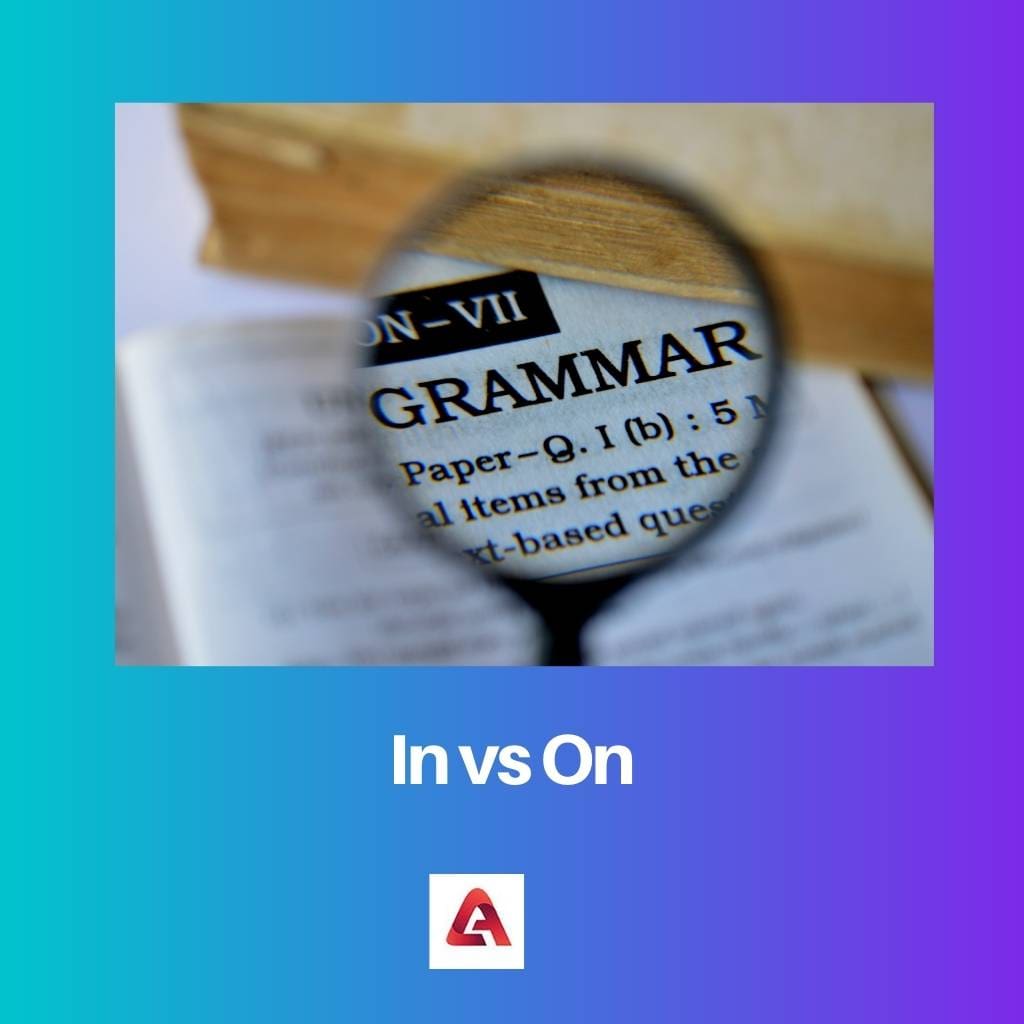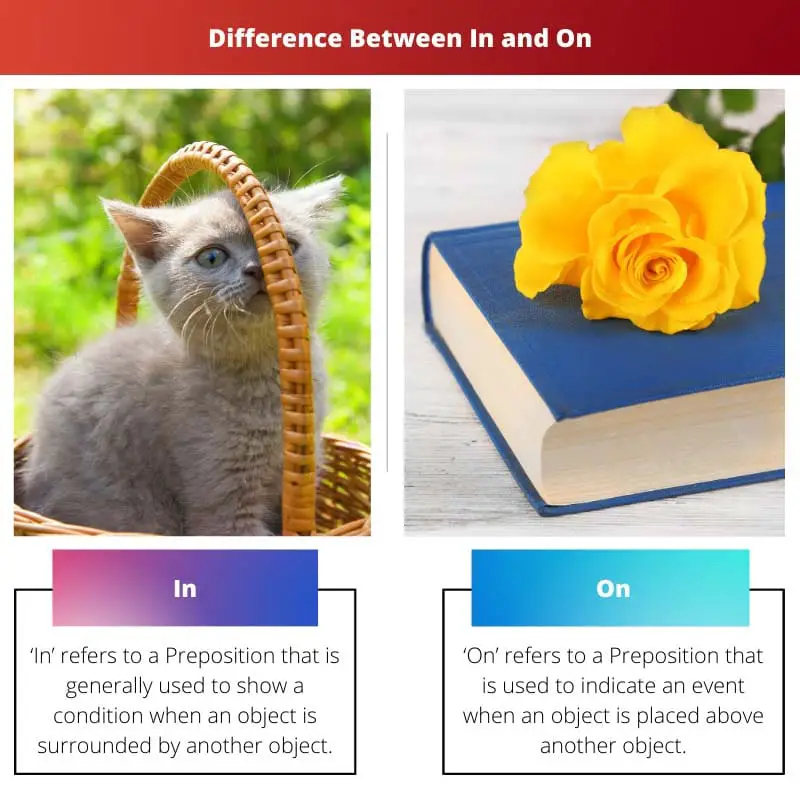Prepositions are words or collections of words that are applied before a noun, pronoun, or phrase to indicate the direction, spot, or time or to inject an object.
Key Takeaways
- “In” is a preposition that denotes being enclosed or surrounded, expressing a sense of containment, location, or time.
- “On” is a preposition that signifies being above or resting on the surface of something, indicating contact, position, or time.
- Usage of “in” and “on” depends on context; for example, “in” is used for locations like buildings or countries, while “on” is used for surfaces like tables or streets.
In vs On
The difference between ‘in’ and ‘on’ is that we need to use the word ‘in’ when we are speaking about a state in which some other thing embeds something, whereas if we talk about ‘on’ it means we are talking about a condition where an object is located or placed over or outside some other object.

‘In’ is used to indicate that some object is stored or is inside some other object. For example:
- The document is on the desk.
- The insect is in the hive.
‘In’ is also used to indicate a consequence included in time.
- I like to eat food in the evening.
- Sanjay’s birthday is in August.
‘On’ is used to designate a position for the surface on which the object is placed. For example:
- Rahul sat on the chair.
- The charger is placed on the desk.
‘On’ is also used for specifying a specific day or date. It may also be used to indicate a special event or program. For example:
- My Engagement is on September 22.
- We shall meet you on Saturday!
Comparison Table
| Parameters of Comparison | In | On |
|---|---|---|
| Definition | ‘In’ refers to a Preposition that is used to show a condition when an object is surrounded by another object. | ‘On’ refers to a Preposition that is used to indicate an event when an object is placed above another object. |
| Usage by place | Name of city, state, and nation. | It is only used for indicating places like street names. |
| Usage by Time | It is used for indicating months, years, season, century, and decades. | It is used for indicating normal days, dates, and specific events. |
| Example of Usage by place | Ahmed lives in Florida, America. | Anuj is on his way to Chennai. |
| Example of usage by time | Titanic was released in the year 1996. | John will meet Michael on Thursday. |
What is ‘In’?
‘In’ can be categorized as a Noun, Adjective, Adverb, and, most importantly, a Preposition. ‘In’ can be said to be a noun if it is utilized to denote support or ability to influence.
‘In’ can also be considered to be an Adverb in certain cases if it is used to transform a verb or an adjective. For example:
- The Prime Minister of the country walked in.
- Please, mix in the milk and water.
‘In’ can also be categorized as an Adjective when it is used to represent a noun or a pronoun. For instance:
- It is what the in custom Audience is buying this month.
- Mr. Sharma is in the house.
‘In’ many times, in general, is classified under Prepositions when it is used to indicate the duration of the season, indicate a location, or indicate that an object is inside another object. For example:
- They both met each other in 1988.
- Reema got wounded in the arm.

What is ‘On’?
‘On’ can be categorized as Adverbs, Adjectives, and, most importantly, Prepositions. In addition to all of these, ‘on’ is also put after some verbs, nouns, and even adjectives. For example:
- Andrew is sitting beside David on the Bed.
- On the Dining table were baskets piled high with fruits and vegetables.
Examples of ‘on’ as an Adverb are:
- Garima put her hat on while Akash opened the main gate.
- Preeti told Mayank that she would not be joining him as she had a lot on in the next month.
Examples of ‘on’ as an Adjective are:
- There’s an amazing match on at the World Cup at the present moment.
- Every year the committee used to put a drama on at Kings College, London.

Main Differences Between ‘In’ and ‘On’
- ‘In’ is used as prepositions, adverbs, adjectives, and pronouns. ‘On’ is used mainly as prepositions but sometimes also used as adverbs and adjectives.
- Reema and Rohan met each other in 2014 is an example of ‘in’, whereas Reema and Rohan met each other on Monday last week is an example of ‘on’.

- https://www.cambridge.org/core/journals/journal-of-child-language/article/learning-to-use-prepositions-a-case-study/5DD9102F0B6BC31CF50ABA9DA936C7AF
- https://www.degruyter.com/document/doi/10.1515/9783110847420.229/html

The article’s explanations provide a complete understanding of ‘in’ and ‘on’.
I appreciate the level of detail provided in the article.
The detailed attention given to the comparison between ‘in’ and ‘on’ was very informative and illuminating.
I find the article to be very didactic.
I think the examples used in this article are very effective in demonstrating the variations of use for ‘in’ and ‘on’.
Agreed. A well presented article.
This article has helped me to distinguish when to use ‘in’ and ‘on’ more precisely.
I believe the examples have clarified the distinction effectively.
The comparison table is very well done, it compares and contrasts their uses effectively.
The article made it clear when to use ‘in’ and ‘on’.
The table is a great reference.
This detailed information helps clear up any confusion about when to use ‘in’ and ‘on’.
Exactly, it provides a complete understanding of the subject.
The examples make it easier to understand and apply in different scenarios.
I appreciate the examples provided about the grammatical functions of ‘in’ and ‘on’.
The article was useful in furthering the understanding of ‘in’ and ‘on’.
The explanations about ‘in’ and ‘on’ as nouns, adjectives, adverbs, and prepositions are very informative.
The article was comprehensive and educational.
I learned a lot about the functions of ‘in’ and ‘on’.
Thank you for the detailed explanation of the differences between ‘in’ and ‘on’. It’s very helpful.
Yes, thank you for making it clear.
I appreciate the examples provided.
The examples of ‘on’ functioning as adverbs and adjectives are particularly useful in understanding the differences.
It is beneficial to have such clear explanations.